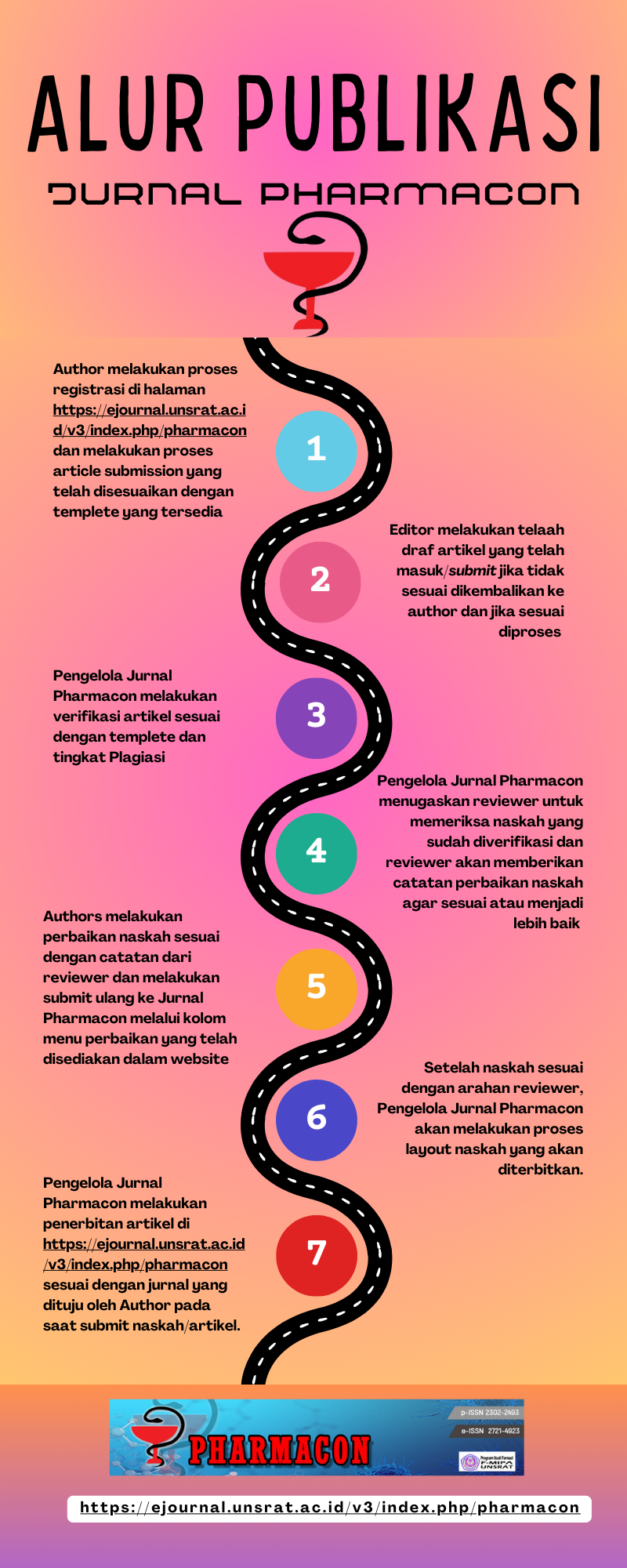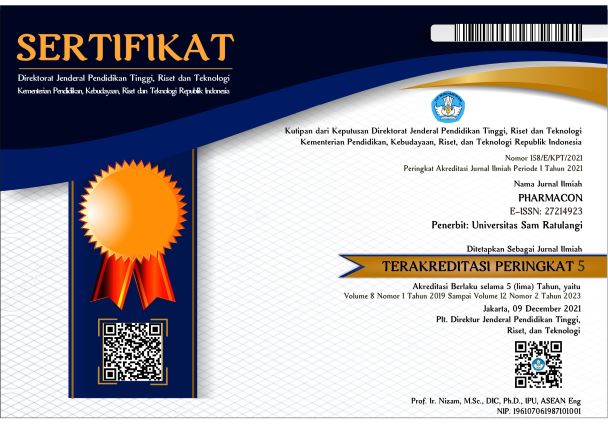UJI EFEK ANTIBAKTERI JAMUR ENDOFIT PADA TUMBUHAN SEREH (Cymbopogon citratus) PADA BAKTERI UJI Staphylococcus aureus DAN Escherichia coli
DOI:
https://doi.org/10.35799/pha.8.2019.29395Abstract
ABSTRACT
Â
Endophytic fungi are fungi that live in plant tissues and do not harm these plants. Endophytic fungi can produce compounds that have the potential as antibacterial. This study aimed to examine the antibacterial effects of endophytic fungi isolated from the lemongrass (Cymbopogon citratus) against Staphylococcus aureus and Escherichia coli bacteria. Lemongrass is used to inhibit or kill pathogenic bacteria because it contains essential oils that function as an antifungal and antibacterial against several pathogenic bacteria such as Staphylococcus aureus and Escherichia coli. The laboratory experiment method tested the antibacterial activity of endophytic fungi isolates obtained from lemongrass (Cymbopogon citratus) against Staphylococcus aureus and Escherichia coli using hole / well method. From the results of the study, four endophytic fungi were isolated from the roots and leaves of lemongrass (Cymbopogon citratus). Antibacterial results showed that endophytic fungi extract isolated from lemongrass plants was more effective in inhibiting Staphylococcus aureus compared to Escherichia coli bacteria. In Staphylococcus aureus bacteria the average inhibitory value is 5-9 mm while in Escherichia coli bacteria the average inhibitory value is only 3 mm. Endophytic fungi from lemongrass roots have a better antibacterial effect compared to endophytic fungi from lemongrass leaves. Conclusion, endophytic fungi isolated from the roots and leaves of lemongrass (Cymbopogon citratus) have an antibacterial effect on the growth of S. aureus bacteria and are not effective against E. coli bacteria. This endophytic fungus isolate is more active against Gram positive (+) bacteria and less active against Gram negative (-) bacteria.
Â
Keywords: Lemongrass plants, Endophytic Fungi, Antibacterial Activity, Staphylococcus aureus, Â Escherichia coli.
Â
ABSTRAK
Â
Jamur endofit ialah jamur yang hidup di dalam jaringan tumbuhan dan tidak membahayakan tumbuhan tersebut. Jamur endofit dapat menghasilkan senyawa yang berpotensi sebagai antibakteri. Penelitian ini bertujuan untuk menguji efek antibakteri jamur endofit yang diisolasi dari akar,batang dan daun tumbuhan sereh (Cymbopogon citratus) terhadap bakteri Staphylococcus aureus dan Escherichia coli. Sereh digunakan untuk menghambat atau membunuh bakteri patogen karena mengandung minyak atsiri yang berfungsi sebagai antijamur dan antibakteri terhadap beberapa bakteri patogen seperti Staphylococcus aureus dan Escherichia coli. Metode penelitian secara eksperimen laboratorium menguji aktivitas antibakteri dari isolat jamur endofit yang diperoleh dari tumbuhan sereh (Cymbopogon citratus) pada bakteri Staphylococcus Aureus dan Escherichia Coli menggunakan metode lubang/sumuran. Dari hasil penelitan diperoleh empat jenis jamur endofit yang diisolasi dari akar dan daun tumbuhan sereh (Cymbopogon citratus).  Hasil penelitian antibakteri menunjukkan bahwa ekstrak jamur endofit yang diisolasi dari tumbuhan sereh lebih efektif menghambat bakteri Staphylococcus aureus dibandingkan dengan bakteri Escherichia coli. Pada bakteri Staphylococcus aureus nilai rata-rata daya hambat yaitu 5-9 mm sedangkan pada bakteri Escherichia coli nilai rata-rata daya hambat yaitu hanya 3 mm. Jamur endofit dari akar sereh memiliki efek antibakteri yang lebih baik dibandingkan dengan jamur endofit dari daun sereh. Kesimpulan, Jamur endofit yang diisolasi dari akar dan daun sereh (Cymbopogon citratus) memiliki efek antibakteri terhadap pertumbuhan bakteri S. aureus dan tidak efektiv terhadap bakteri E. coli. Isolat jamur endofit ini lebih aktif pada bakteri Gram positif (+) dan kurang aktif pada bakteri negatif (-).
Â
Kata Kunci : Tumbuhan Sereh, Jamur Endofit, Aktivitas Antibakteri, Staphylococcus aureus, Escherichia coliDownloads
Published
How to Cite
Issue
Section
License
Authors who publish with this journal agree to the following terms:
- Authors retain copyright and grant the journal right of first publication with the work simultaneously licensed under a Creative Commons Attribution-NonCommercial 4.0 International License that allows others to share the work with an acknowledgement of the work's authorship and initial publication in this journal.
- Authors are permitted and encouraged to post their work online (e.g., in institutional repositories or on their website) prior to and during the submission process, as it can lead to productive exchanges, as well as earlier and greater citation of published work (See The Effect of Open Access)










